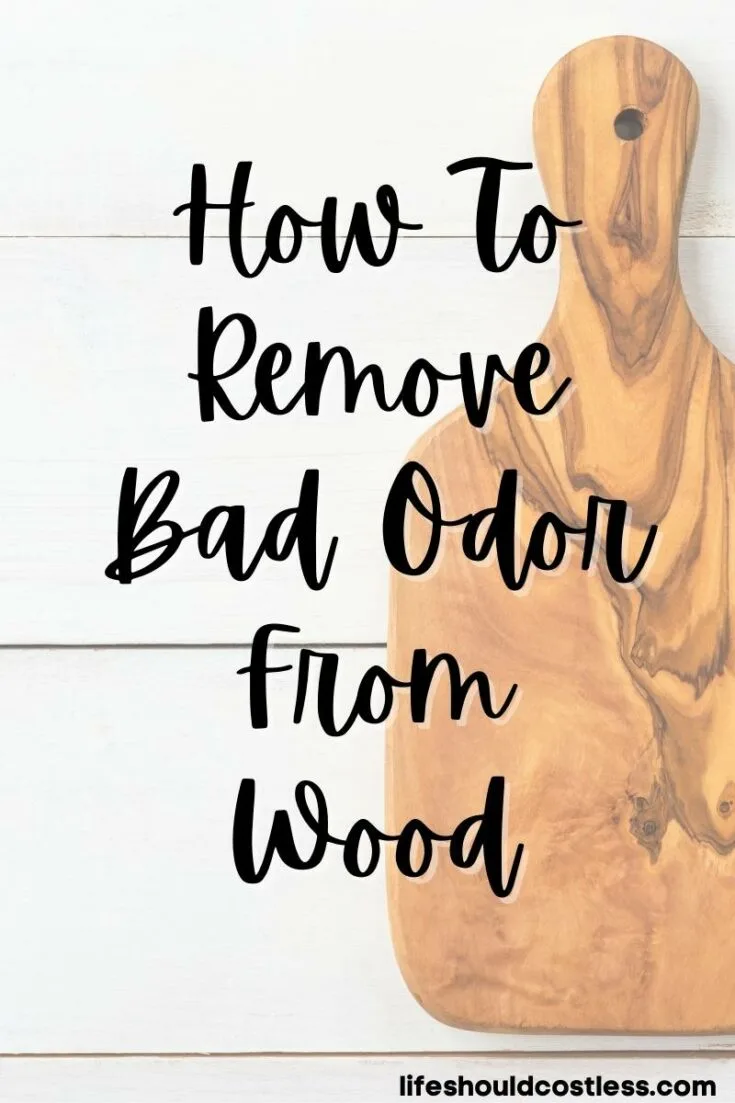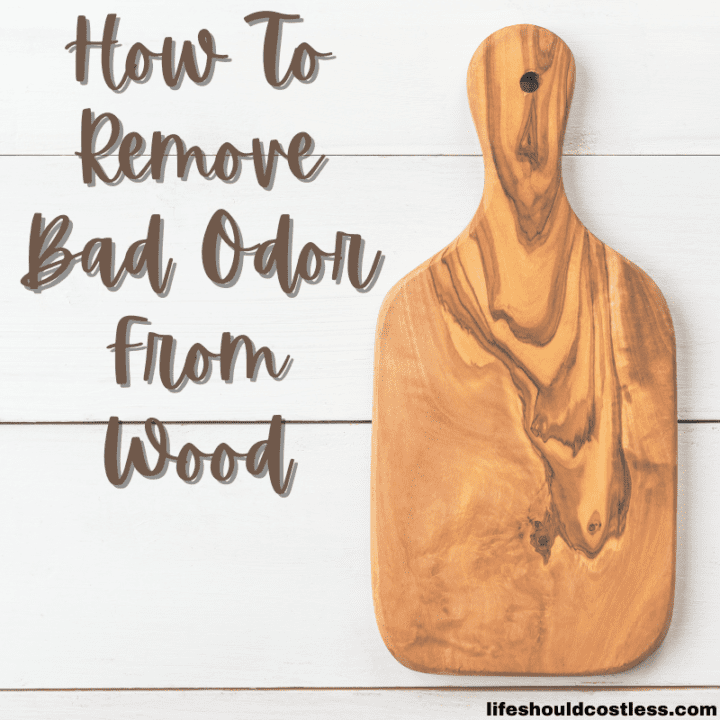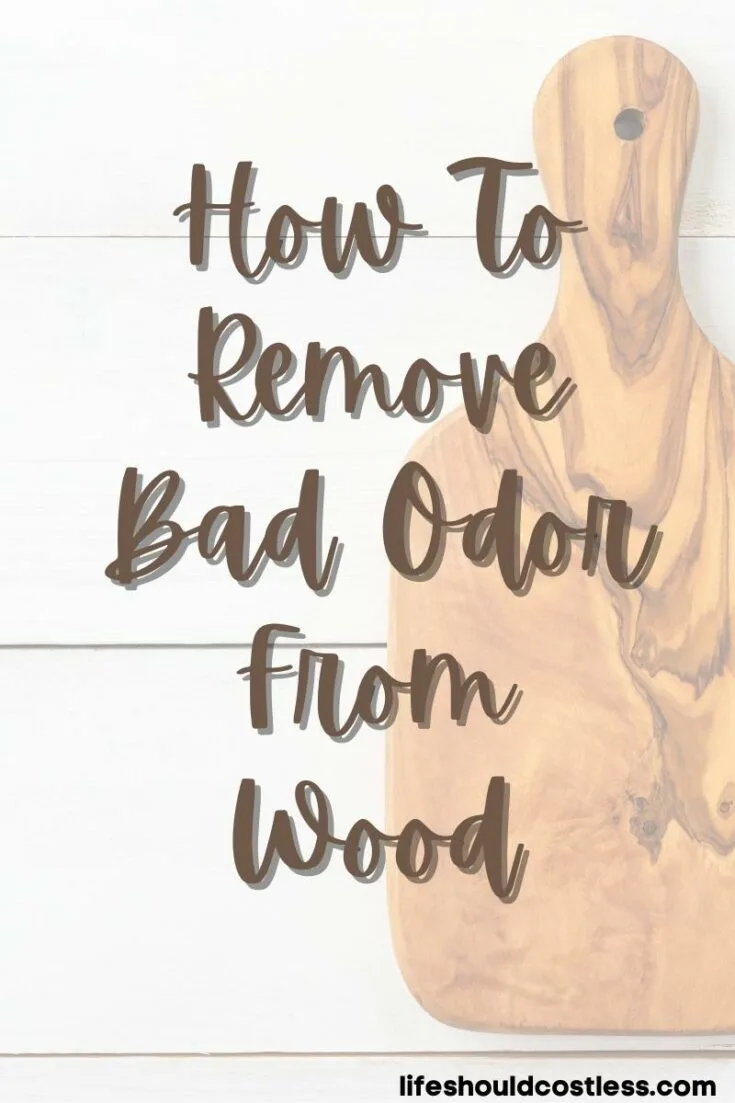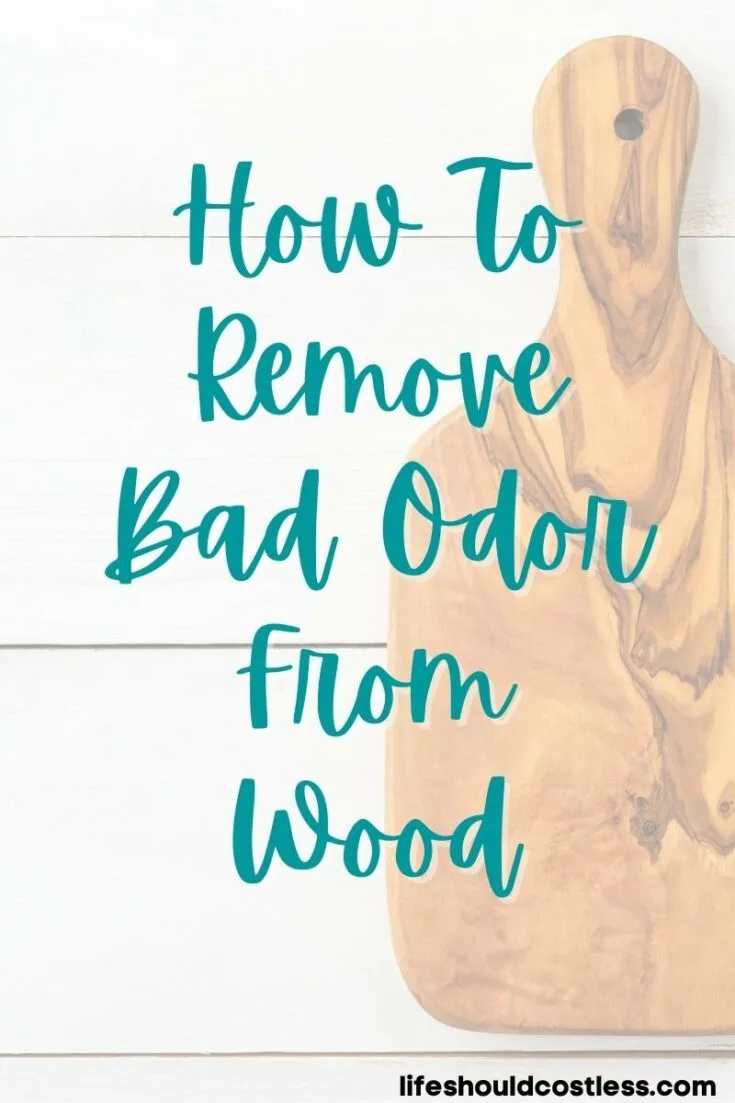Whether you have a chopping block, a wooden cutting board, frequently use a wood charcuterie board, or you even do your food preparation cutting on a full on butcher block…it’s all wood, and wood can sometimes take on a very rancid smell. There are many different ways to deodorize or neutralize the odors and remove the stinky smells, so let’s dive into learning how to remove bad odors from wood, so you can decide which method would work best for your situation.

If you found this post, odds are that you probably googled something like “wooden cutting board smells like onions/ or smells rancid”…or something similar (lol)…
Lucky for you, I have already done the hard work of both researching the best ways to take care of the bad smells.
I have also put them to the test in my own home so that we all can have wooden chopping blocks/boards that not only smell better, but are more sanitary in general too.
How to clean wooden board:
Before we can dive deep and get out those deeply embedded smells out, we need to make sure that you know how to do your basic wood chopping board cleaning.
Because it’s entirely possible that your board just needs a good, thorough, basic cleaning to remove those funky smells…
Especially if you’re using a second-hand board (yes, they can be a hand-me-down or a thrift store/yard sale find…or one that is built in in an older homes kitchen).
Many people seem to think that just rinsing it off will be enough to “clean it”…but rinsing really is not adequate to keep them clean and stink-free.
If you have a chopping board that can fit into your kitchen sink, let’s start there.
Fill your sink (or a clean bath tub works too depending on how big your board is) with some hot soapy water and, using a clean rag or a gentle brush, scrub the entire thing down really well.
Then you rinse well, and set it upright (not laying flat) in your drying rack until it has completely dried out.
Doing so allows your board to dry properly and prevents bacterial growth due to water not draining from the cracks and crevices(Sidenote: Make sure not to leave your board sitting and soaking for long periods of time…this will damage it).
If you would like to use a “hot soapy” method to clean your free-standing butcher block (because those things absolutely won’t fit into a sink, or even a tub for that matter…lol), you can fill a spray bottle with warm soapy water, spray it down, and using a cleaning brush or rag to scrub the whole thing down really well.
Wipe it all off with a clean rag or towel, and then use a spray bottle filled with warm water to spray it down, wipe the fresh water off with a fresh dry towel/rag…and repeat the rinsing as much as necessary so that there is no more soap residue/bubbles.
I suggest running a fan in the room when you are done if you have a non-moveable butcher block so that it will aid in drying out the nooks and crannies faster.
How to remove bad odor from wood:
Alright, so, if you gave your wooden board a thorough cleaning, as I suggested above, and it is still putting off some really bad smells, it’s time to do the deeper cleaning to deodorize/neutralize the funk.
I am a big fan, of telling you about the multiple ways of doing things, because I honestly believe that there is more than one right way to do things (however, I will tell you which method I think is the most effective/best).
That way, you can browse all of the different options and pick whichever one is either right for you and your personal situation.
Or, telling you all the different ways to deodorize a rancid cutting board, will also allow you to do so as frugally as possible because sometimes we just need to use things that we already have on hand to solve a problem.
I get it, money can sometimes be tight and you may just need a cheap solution to your stinky wood situation.
So, let’s just jump right into the different options.
Methods For Odor Removal:
The first method, is all over the internet, so I’d be surprised if you haven’t heard about using some salt and either a lime or a lemon.
You basically just cut your citrus of choice in half… pour some salt on your board, and in a circular pattern you use the wet part of the fruit over the salt and do some soft scrubbing.
If you go this route, I suggest that you be meticulous not to “miss a spot”… then let it dry on your board (out in the sun is preferable as the sun has a natural bleaching effect). Then I would follow that up with washing and re-seasoning your board as usual.
Next method is to try using baking soda, water, and a rag, you can create a paste, and also soft-scrub your board/wooden surface.
Baking soda is a natural deodorizer so this method seems to work well… however, if your smells are funkier than usual, you could try adding a couple of drops of lemon/lime/orange/or grapefruit essential oils to your baking soda “paste”. Also allow it to dry and then wash/season as normal.
Make sure to pay extra attention to the deeper cuts in the board for all of the suggested cleaning methods.
The third method…if you would like to start with regular white vinegar (another non-toxic/natural method to deodorize), you can either saturate a rag in it, lay it across your board, and let it soak directly on your board for a few minutes.
Or you can pour some straight (undiluted) into a spray bottle and spray down your board thoroughly…let it sit for a couple of minutes.
Either way, allow it to soak a little while and then rinse well with water, put it on your drying rack (standing up), and allow it to dry completely before use.
By the way, baking soda/water paste, plus adding a little citrus essential oil is my preferred method to get this job done, just make sure you rewash it and re-season it really well afterwards because the wrong kind of oils can go rancid on a chopping board.
How to sanitize a wood cutting board:
If you cut raw meats or fish on your surface, you’re going to want to pay extra attention to this part because we need to kills the bacteria germs, not just to get the smell out, but so we’re not getting anyone sick because we didn’t properly clean our wooden surface.
*If you are using wood chopping blocks, make sure that whenever possible, you are using a different chop block for raw meat vs all of the other things that you are chopping, this will also help prevent any sicknesses.*
According to Clorox.com in order to kill the bacteria in any type of cutting board, not just wood, you need to take a few steps (Clorox does have a full tutorial video, here’s the link if you would just like to watch it)
I prefer to just send you to their method as I am no Dr., or Scientist, and don’t want anyone getting sick on my account…so now you know “from the experts” how to disinfect those things.
How to prevent future smells in wood chopping blocks:
The secret to prevention of rotten smells is knowing how to take care of your wood chopping surface to begin with.
So, we already went over how to do a basic general cleaning, and remember not to ever just rinse off your board…food particles get trapped in those cracks, even if they’re microscopic and you can’t see them…they’re in there.
I did also specify that you should make sure to not lay your board flat to dry…it needs to be upright to prevent bacterial growth due to it taking too long for it to dry on its broad side.
Make sure to season, or re-season, your board as often as necessary.
Not only will this prevent things from getting embedded deeper in those cracks and crevices, it will also make your board last for years and years, and it is much less likely to splinter.
I do not have my own tutorial for “how to season a wood cutting board”, so I made sure to look up one of the best resources (in my personal opinion anyway) to show you how to season your wood surface properly so that you will get the most enjoyment and use out of your chopping block as possible.
Here is the link to that tutorial…and keep in mind that they say that you can use the same method to season those wooden bowls, forks, and spoons too!
That is all that I can think of to share with you guys about solving the issue for “wood that smells”… so I hope that you found one of these tips helpful.
Thanks so much for stopping by my blog and supporting my endeavors to make people’s lives a little easier/better. If you liked this cleaning post, or found it helpful in any way, please make sure to share it with your family, friends, and co-workers via social media…or you could even send them the direct link via email. Whichever way you choose to spread the love, I super appreciate it! ~Sarah

How To Follow & Support This Site
- If you would like to subscribe to my email list, go here.
- Make sure to follow along via social media, by going here.
- If you would like to learn how to really show your support to this site (at no cost to you), go here.
- If you would like to make a direct donation to the site, go here.
If you would like to check out my entire collection of handy cleaning tips and tutorials, you can do so here.
Here are direct links to several of my other helpful posts, you’re definitely not going to want to miss these ones that I hand-picked to share in this post:
For those of you that would like another option of a “pinnable image” to share on Pinterest, here you go, thanks again so much for the support!:


*This post was originally published to this website on February 23, 2022 and has been/will be continually updated to remain current, be as user friendly as possible, as well as to improve social shareability.
